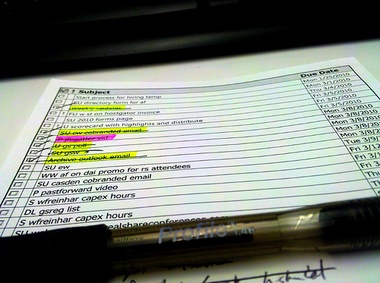I’ve been writing about productivity for years. I’ve reviewed books, audio courses and what feels like every piece of productivity advice out there. Along the way, I’ve discovered a secret: What works for David Allen doesn’t work for me, at least not exactly. The same goes for Steve Pavlina, Gina Trapani and every other productivity expert active online and in print. What’s more, they almost certainly don’t work perfectly for you, either. Don’t get me wrong — odds are good that, over the years, you’ve found something that comes close. Maybe your system is very recognizable to someone who’s read up on your favorite productivity guru. But you’ve probably made a few tweaks and hacked the system a bit. It could be something small, like finding a way to force yourself to look at your task list on a regular schedule or giving your significant other a way to add tasks to your to-do list.
Generalized Productivity Advice for Individuals
While it may sound trite to say that we’re each unique snowflakes, it’s not entirely inaccurate when it comes to productivity advice. Different people process information differently, prioritize tasks differently, even procrastinate differently. That makes sorting through all the productivity advice out there both crucial and difficult. No one wants to try out every new system that comes along for organizing your task list — besides simply going crazy, you’d probably drop the ball on about half the tasks you wanted to complete as you shifted between systems. The alternative seems to be finding something that generally works (although rarely works perfectly) and going with it, keeping the changes to a minimum. Making a major adjustment more than every year or so is too often. But that essentially means that most of us settle for the first half-way decent approach to managing tasks that comes along. There must be a reasonable compromise that doesn’t leave us limping along with a system that doesn’t quite work for us, but that we can’t afford to change.
Narrowing Down the Hunt
The first step to getting a grasp on everything you need to get done shouldn’t be to find a system that seems to work well for a lot of people. Instead, start with yourself. You have to know how you operate — how you think. Are you motivated by checking boxes off on your list? Do you need a physical reminder to check in on your next step? The more you know about how you function, the easier it is to be able to dismiss productivity advice that doesn’t work for you. The more you can dismiss, the better. It leaves far less to sort through. You can also develop the ability to identify advice that will work without necessarily having to try it out. If you find a core system that allows you to function pretty well, you’ll be able to tweak it with the smaller pieces of productivity advice that comes along without having to scrap the whole system and start over. Finding the right core for your system lets you stay in charge, rather than letting an uppity organizer or web application run your life.
Beyond the Standard Advice
There is a certain amount of cross-pollination going on among the acknowledged productivity and self-development experts out there. One blogger may link to another’s post; one writer may use another’s idea as a principle in a new approach. That can be good, but it does mean that many of the systems out there look surprisingly similar when you get them out of the box and on to the table. If you can draw on ideas from outside the field, you can find some tips and help that may surprise you. Personally, I’ve found a lot of tricks that work well for my approach to getting my work done in how athletes train. Be open to new perspectives on productivity, even when they don’t look like productivity on the surface. You may be surprised at how well new ideas will work. Image: Chirag D. Shah Click Here to join Lifehack readers on Facebook!
